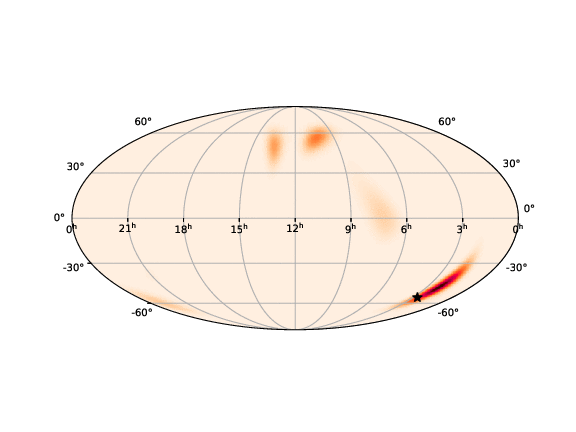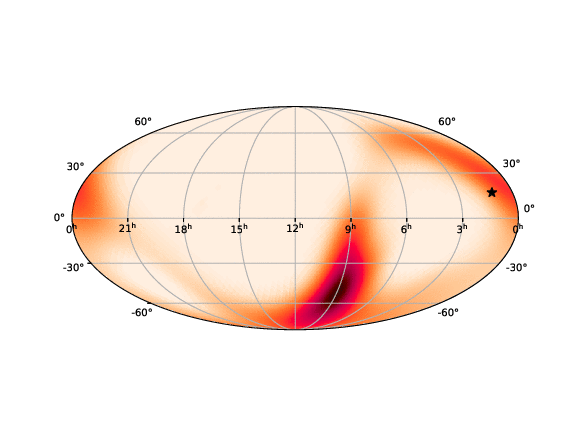Early-Warning Alerts¶
BNS mergers spend several minutes in band of the Advanced ground-based gravitational-wave detectors. For some loud and nearby BNS mergers, it is possible to accumulate enough SNR and detect them several tens of seconds before merger. During O3, automated public alerts for CBC events have been sent within as little as 2 minutes after merger. In O4, we have commissioned search pipelines that can detect BNS events before merger if the signal is sufficiently strong.
Since it is generally assumed that detectable electromagnetic (or neutrino) emission starts shortly after merger, a pre-merger gravitational-wave detection would provide early warning of an impending electromagnetic transient and might make it possible for automated follow-up facilities to capture any prompt emission from the merger environment, the jet, and other unknown activity.
We had previously conducted a trial early warning public alert infrastructure in June 2020 replaying an 8-day period of archival LIGO data from O3. Results from this study were published in [1]. This study demonstrated that in principle it is possible to send out GCN Notices in advance of a BNS merger.
Detection Method¶
All of our CBC search pipelines (GstLAL [2], MBTA, PyCBC [3], and SPIIR [4]) are participating in early-warning alerts. See the Alert Contents section for details about alert types and contents. See the Online Pipelines section for details on these analyses. Localizations will be produced with BAYESTAR; see the Sky Localization and Parameter Estimation section for details.
BNS signals sweep up smoothly in frequency for a few minutes across the Advanced LIGO band. In that time, they may accumulate enough SNR to be detected before merger. A GW170817-like system with a total network SNR of 32 will already accumulate an SNR of 11 by the time the signal sweeps up to 30 Hz, about a minute before merger.
The time evolution of the gravitational-wave frequency and the cumulative SNR for a GW170817-like BNS system.¶
The early warning search is a matched-filter search that uses templates that
have been truncated at a selection of end frequencies—or equivalently, cut
off at a selection of times before merger. The following tables give, for each
search pipeline, the ending frequencies and corresponding times before merger.
The relationship between frequency and time is approximate and assumes
a BNS with masses
GstLAL:
Frequency (Hz) |
Time before merger (s) |
|---|---|
29 |
60 |
32 |
46 |
38 |
29 |
49 |
15 |
56 |
10 |
MBTA:
Frequency (Hz) |
Time before merger (s) |
|---|---|
34 |
39 |
42 |
22 |
50 |
14 |
58 |
9 |
PyCBC Live:
Frequency (Hz) |
Time before merger (s) |
|---|---|
29 |
60 |
32 |
46 |
38 |
29 |
44 |
20 |
49 |
15 |
56 |
10 |
SPIIR:
Frequency (Hz) |
Time before merger (s) |
|---|---|
29 |
60 |
31 |
50 |
34 |
40 |
38 |
30 |
44 |
20 |
56 |
10 |
Source Classification¶
The automated source classification and properties have not been trained or tested extensively for early warning alerts. However, the early warning analysis is only optimized for BNS-mass mergers. As a result, the assumed source class in early warning GCN Notices will always be BNS or Terrestrial, with an assumption of a 0% chance of NSBH or BBH. The HasNS and HasRemnant fields will likewise always show 100%.
Localization¶
Sky localizations for early warning alerts are typically very coarse because the early warning analysis inherently does not make use of the full duration and bandwidth of the gravitational-wave signal. The localization improves slowly up until the last second before merger, and then converges rapidly in the last second.
The animations below taken from the data release [5] show the evolution of early-warning sky maps for three representative events with different SNR values. Note that this study assumed the detectors to be operating at their final design sensitivity.
Final SNR |
11 |
18 |
25 |
|---|---|---|---|
Distance |
250 Mpc |
210 Mpc |
160 Mpc |
Sky map (animated GIF) |
|||
Frequency |
Localization accuracy (90% credible area) |
||
29 Hz |
Not detected |
Not detected |
12000 deg2 |
32 Hz |
10000 deg2 |
||
38 Hz |
9200 deg2 |
8200 deg2 |
|
49 Hz |
2300 deg2 |
1000 deg2 |
730 deg2 |
56 Hz |
1000 deg2 |
700 deg2 |
250 deg2 |
1024 Hz |
10 deg2 |
31 deg2 |
5.4 deg2 |


